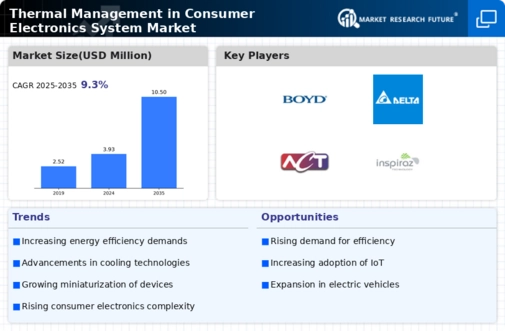Market Analysis
In-depth Analysis of Thermal Management in Consumer Electronics System Market Industry Landscape
The global thermal management in consumer electronics system market is set to reach US$ 7,992.9 MN by 2032, at a 9.3% CAGR between years 2023-2032. The dynamics of the thermal management in consumer electronics system market describe a complicated interrelationship between numerous factors impacting effective dissipation process associated with heat generated by devices that are electronic. Critical also thermal managing, especially taking into consideration on how consumer electronics continuously developments by enhancing component efficiency becoming more and more powerful but have compact design. Prioritizing the need for compact, high-performance gadgets such as laptops tablets and gaming consoles enables more demand to promote efficient thermal solutions. This demand arises from the effect of increased thermal risk as it can cause device overheating, resulting in reduced performance and reliability. Indeed, technological innovations have been the revolutionizing primary factor determining market competition quite determine of the TMT industry in a consumer electronics.
General The warmth that is generated also increases, as manufacturers seek to improve the processing ability and capabilities of devices. These innovations in heat sinks, thermal interface materials, and cooling systems are now required to reduce this extra heat without wasting precious energy that is being generated by the working power plant. Such quest for solutions to balance performance and thermal efficiency is the goal that guides this market of consumer electronics encouraging consumers to have both function and usage intact without sacrificing either when they use such devices. The fate of the market dynamics in this case is also impacted by global financial issues. Such economic situations determine consumer purchasing power and preferences from goods, which ultimately shapes the nature of consumer electronics demand in the market.
On the other hand, due to changes in economic level fluctuations can affect materialistic price and production process so it also impacts on the given problem of thermal management solutions. This is due to threats that are related to lower profit margins therefore there is need for wholesalers and manufacturers in this area must maneuver economic uncertainties while meeting market demands. A strong competitive landscape among thermal management for consumer electronics players unfolded a wave of product development activity and aggressive strategies. Many companies compete in the market with competitive pricing and innovative solutions for their customers along with standard quality they can rely on. The rise of newer, more high-end consumer electronic devices makes it necessary for thermal management solutions providers to maintain product development by continuously conducting research and trials to understand the increasingly complex nature of addressing thermal challenges posed by these products.
In this competitive industry, the capability of providing substantial cooling solution with compact size becomes one of the main factors to get ahead from the competition. In addition, government regulations and the industry standards in thermal management of consumer electronics also contribute to its market dynamics. Safety standards, environmental rules and finally energy effectiveness is essential in this regard. As these regulations need to be incorporated into manufacturing and solutions providers’ products, other offerings from firms, and governments have sustainability as a consumer market requirement modernization.







Leave a Comment